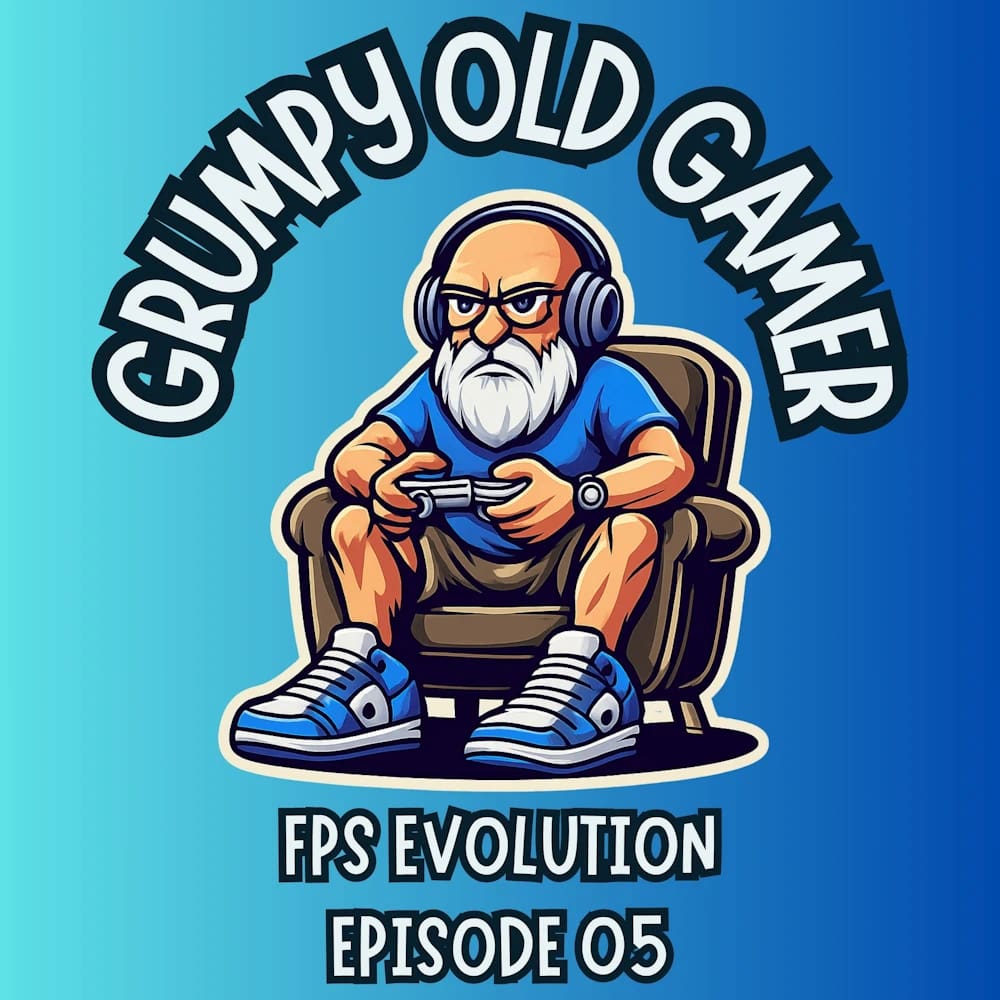Ian, Al, and Tim trace the evolution of first-person shooters from obscure 1970s research projects to today’s AAA behemoths, discovering that the genre’s golden age might have been the single-player story campaigns they all miss.
This episode explores how FPS games evolved from NASA research projects to console exclusives, examining the technical innovations that shaped modern gaming. The discussion covers the divergence between hardcore PC gaming and casual console experiences, the rise of multiplayer dominance, and why today’s microtransaction-heavy shooters lack the personality of classic protagonists. Three grumpy gamers conclude that while graphics improved, the soul of FPS gaming might be trapped in annual release cycles and cosmetic DLC.
Grumpy Old Gamer Podcast – Episode 5 Show Notes
Episode Title: FPS Evolution: From Maze War to Modern Warfare
Hosts: Ian, Al, Tim
Episode Length: ~48 minutes
Episode Summary
In the fifth episode of the Grumpy Old Gamer podcast, the hosts trace the complete evolution of first-person shooters from forgotten 1970s research projects to today’s billion-dollar franchises. Starting with Maze War and Spasim, they explore how technical limitations shaped early game design, examine the golden age of id Software, and discuss the critical split between PC and console gaming. The conversation reveals their shared nostalgia for single-player campaigns and character-driven narratives, while critiquing modern FPS games’ focus on microtransactions over meaningful gameplay experiences.
Key Topics Discussed
The Forgotten Origins (1970s)
Maze War (1973-1974):
- Created by high school/college students during NASA work placement
- First prototype FPS allowing movement and shooting in 3D space
- Primitive graphics but revolutionary concept for its time
Spasim (Mid-1970s):
- Featured groundbreaking 32-player multiplayer support
- Ran on severely limited hardware (4 kilobits of memory)
- Refresh rate of approximately one frame per second
- Demonstrated multiplayer gaming potential decades before mainstream adoption
Research Project Legacy:
- Both were academic research projects, not commercial games
- Laid foundational concepts for modern FPS gaming
- Showed early vision of networked multiplayer experiences
The id Software Revolution (1992-1996)
Wolfenstein 3D (1992):
- First commercially successful FPS game
- Generated controversy for violence simulation
- “It’s Nazis, so you can blow ’em away without worry”
- Featured iconic MechaHitler boss fight
- Available primarily on floppy disc for IBM 386 machines
- Set technical and cultural groundwork for Doom
Doom (1993):
- Cultural phenomenon with 3.5 million sales
- Coined the term “ultra violence”
- Similar media backlash to later GTA controversy
- Established FPS gaming for mainstream audiences
- Strong modding community foundation
- Masters of Doom book chronicles development and cultural impact
Quake (1996):
- First true 3D FPS with full look-around capability
- Nine Inch Nails soundtrack “absolutely slaps”
- Nine Inch Nails logo appeared on ammunition boxes
- Introduced rocket jumping mechanics
- First game allowing players to look up and down manually
- More atmospheric and scary compared to Doom’s fun factor
- Ominous devil-worshipping themes created tension
The Character-Driven Era
Duke Nukem 3D (1996):
- Competed directly with Quake for market attention
- Crammed every pop culture reference into all-American action hero
- Iconic quotes: “I’m gonna rip your head off and shit down your neck”
- Boss fight literally depicted this threat
- Movie theater level with secret wall passages
- Mini-rocket fist weapon remains underappreciated
- Shareware demos distributed via magazine floppy discs
Technical Innovation Highlights:
- Doom’s BFG as iconic weapon design
- Quake’s true 3D movement vs. Doom’s 2D limitations
- Level design evolution from simple mazes to complex 3D spaces
- Physics-based gameplay elements introduction
The Console Revolution
GoldenEye 007 (1997):
- First FPS designed exclusively for consoles (Nintendo 64)
- Unique control scheme: single thumbstick with static free-aim mode
- Players had to stop moving for precision shooting
- Expert players learned rapid static-aim techniques
- Odd Job character banned from multiplayer due to hitbox advantage
- Captured James Bond atmosphere perfectly
- Pioneered console-specific FPS design philosophy
Halo: Combat Evolved (2001):
- Xbox launch title that defined console FPS standards
- “I need to get an Xbox” moment for many players
- Polished gameplay with iconic soundtrack
- Blood Gulch as legendary multiplayer map
- Vehicle-based gameplay with tight driving controls
- Invented custom game modes like “Car Game”
- Master Chief Collection still holds up today
The Great Divide: PC vs Console Gaming
PC Gaming Characteristics (Late 1990s-2000s):
- Hardcore competitive focus
- Mouse and keyboard precision
- Early eSports foundation (Counter-Strike, Quake III Arena, Unreal Tournament)
- Internet connectivity advantages
- GameSpy Arcade for matchmaking
- More serious, dedicated gaming culture
Console Gaming Characteristics:
- Social couch co-op experiences
- LAN party culture
- More accessible to casual players
- Network connectivity challenges initially
- Xbox Live breakthrough with Halo 2 (2004)
The Split Analysis:
- 1996: FPS gaming 90% PC dominated
- 2001: Approximately 50/50 market revenue split
- Console attempts at PC ports often failed (Unreal Championship, Counter-Strike: Ground Zero)
- Different communities developed distinct gaming cultures
Influential Games of the 2000s
Medal of Honor: Allied Assault:
- D-Day beach storming level directed by Spielberg
- Inspired by Saving Private Ryan opening sequence
- “Probably one of the best opening levels of any computer game”
- Strong online multiplayer community
Battlefield 1942:
- Large-scale multiplayer warfare
- Vehicle-based combat innovation
- Demo map so good players didn’t need full game
- Established template for modern large-scale FPS
Half-Life Series Legacy:
- Revolutionary single-player storytelling
- Proved FPS didn’t need to be multiplayer-focused
- Gordon Freeman as silent protagonist archetype
- Story-driven campaigns as artistic achievements
- (Referenced back to Episode 3 for detailed discussion)
Left 4 Dead (2008):
- Cooperative rather than competitive multiplayer
- Four-player team survival mechanics
- Distinguished co-op from traditional multiplayer
- Removed competitive anxiety for casual players
- Al and Tim’s recent positive gaming experience
Modern FPS Landscape Analysis
Call of Duty Franchise Evolution:
- Started as historically-focused WWII games
- Modern Warfare (2007) shifted to contemporary settings
- Annual release schedule criticism
- Heavy microtransaction implementation
- Skin purchases and cosmetic focus
- “Gaming is shit now” embodiment
- Lost artistic integrity for commercial success
Battlefield Franchise Positioning:
- Larger maps and player counts
- More tactical, vehicle-focused gameplay
- Longer development cycles between releases
- Battlefield 6 promises return to military realism
- Rejection of “silly skins” aesthetic
- Hope for franchise returning to roots
Industry Problems Identified:
- Pay-to-win mechanics disgust
- Cosmetic microtransactions distract from gameplay
- Annual release cycles prevent innovation
- Generic military characters lack personality
- Pink guns in military settings break immersion
The Future of FPS Gaming
VR Potential:
- Natural evolution for immersive FPS experiences
- Half-Life: Alyx as proof of concept
- Limited current VR FPS library
- Technology advancement needed for widespread adoption
Desired Features:
- Cross-platform cooperative play
- Return to single-player story campaigns
- Character personality restoration
- Unlockable content through gameplay, not purchases
- “Boomer shooter” revival (Boltgun, Doom 2016)
Missing Elements:
- Protagonists with distinct personalities
- Story-driven single-player experiences
- Cooperative campaign options
- Meaningful progression systems
- Immersive world-building over competitive mechanics
Notable Quotes
On FPS Origins: “I was offended. I was offended. So when we were talking about doing this episode, the Evolution, evolution, evolution of FPS” “This is really fucking boring. People are gonna switch off because this is boring”
On Classic Gaming: “It’s Nazis, so you can blow ’em away and you don’t have to worry about it” “Shake it baby” – Duke Nukem reference “I’m gonna rip your head off and shit down your neck”
On Halo Impact: “I need to get an Xbox. This is so much fun” “Hours of entertainment” – describing custom Car Game mode “Still felt good. Still felt good” – replaying Master Chief Collection
On Modern Gaming Problems: “Gaming is shit now” “I don’t want to have a pink gun or new boots or whatever. I just want a solid gaming experience” “Fucking disgusting. It’s disgusting practice” – on pay-to-win mechanics “I’ve lost all faith now”
On Character Design: “You think of Duke Nukem and you think of quotes and stuff like that… there’s personas there” “Generic person over there and I don’t know who the fuck it is”
On Future Gaming: “I want to see single player FPS games, which are story games” “You are hand in hand with an author writing the book”
Memorable Moments
Elon Musk’s AI Incident: Grok AI calling itself “MechaHitler” and subsequent shutdown
The Bud Light Reference: Tim’s unexpected “WHASSAP” opening attempt
Odd Job Controversy: Explanation of why the character was banned from GoldenEye multiplayer
The McDonald’s Fallacy Callback: Reference to previous episode’s popularity vs. influence argument
Car Game Innovation: Halo custom game mode creation with vehicles only
The BFG Appreciation: Doom’s most iconic weapon discussion
Library Confessions: Steam sale purchase regrets and unplayed games
Pink Gun Rant: Frustration with cosmetic microtransactions breaking immersion
Technical Details and References
Game Release Timeline:
- Maze War: 1973-1974
- Spasim: Mid-1970s
- Wolfenstein 3D: 1992
- Doom: 1993
- Quake: 1996
- Duke Nukem 3D: 1996
- GoldenEye 007: 1997
- Halo: Combat Evolved: 2001
- Medal of Honor: Allied Assault: 2002
- Halo 2: 2004
- Call of Duty: Modern Warfare: 2007
- Left 4 Dead: 2008
Hardware References:
- IBM 386 machines for early PC gaming
- Floppy disc distribution systems
- Nintendo 64 single thumbstick controls
- Magazine demo discs and shareware culture
Modern Comparisons:
- Doom (2016) as proper single-player revival
- Boltgun as “boomer shooter” success
- Space Marine 2 third-person comparison
- Cross-platform gaming evolution
Future Episode Teases
Next Episode: “The Death of Consoles – Are Consoles Really Dead?”
- Console vs. PC gaming future
- Cross-platform gaming implications
- Technology convergence analysis
Mentioned Future Topics:
- VR gaming deep-dive episode
- Star Wars games comprehensive review (Season 2)
- Cooperative gaming experiences
- More industry impact discussions
Contact & Community
Listen: Spotify | Apple | Amazon | YouTube
Follow / Community: Discord | Twitch | Steam | Curator | Facebook | Twitter | Bluesky | Instagram | Threads
Contact: Website | grumpyoldgamer[at]gog.fm
Episode Verdict
The hosts conclude that FPS evolution represents both technological progress and creative regression. While graphics, networking, and technical capabilities have advanced dramatically since the 1970s research projects, modern FPS games have largely abandoned the personality-driven campaigns and innovative single-player experiences that defined the genre’s golden age.
The discussion reveals a shared nostalgia for the era when FPS protagonists had distinct personalities, when unlocking content required skill rather than credit cards, and when cooperative experiences prioritized fun over competition. They argue that the industry’s focus on annual releases and microtransaction revenue has created generic experiences that lack the innovation and soul of classics like Doom, Half-Life, and Halo.
Key Takeaway: Technical evolution doesn’t guarantee creative progress. The hosts advocate for a return to story-driven campaigns, cross-platform cooperation, and gameplay-earned rewards while maintaining modern technical standards.
Discover more from Grumpy Old Gamer Podcast
Subscribe to get the latest posts sent to your email.


